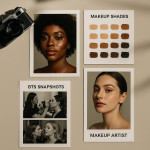Negotiating usage rights: protect a maquilleur's work in multi-channel campaigns
Usage rights determine where, how long and how often a brand can publish your makeup looks. Negotiate them well and you safeguard your creativity, your income and your professional reputation. This guide walks you through a proven framework to secure fair fees and bullet-proof clauses when your artistry appears across print, social, out-of-home or streaming ads.
Why makeup usage rights matter more than ever

Campaigns are no longer single-channel. One photoshoot often fuels Instagram teasers, out-of-home (OOH) billboards and 4K livestreams. If you license your work cheaply “for social only” and the images later hit airport lightboxes, you lose leverage and revenue. Clear usage terms:
- Protect your intellectual property and brand image.
- Generate additional income each time the campaign scope widens.
- Prevent client misunderstandings that sour long-term relationships.
Agencies already scan portfolios to gauge a maquilleur's rights awareness. Strengthen yours by adding deliverable notes and renewal fee ranges, as explained in build a maquilleur portfolio that convinces agencies.
Typical media channels and their legal weight
| Channel | Average audience reach | Usage fee multiplier* | Typical licence term |
|---|---|---|---|
| Organic social | 10 K – 100 K views | 1 × day rate | 6 – 12 months |
| Paid social ads | 0.5 – 5 M impressions | 1.5 × | 3 – 6 months |
| Print magazine | 20 K – 250 K circulation | 2 × | 1 issue |
| OOH billboards | 1 – 20 M impressions | 3 × | 4 – 12 weeks |
| Global TV & streaming | 5 – 50 M viewers | 4 – 5 × | 12 months |
*Based on 2024 Association of Photographers & Beauty Guild surveys.
A five-step framework to negotiate rock-solid rights
1. Audit the brief and campaign map
Ask for a distribution plan before quoting. Confirm:
- Media list (organic, paid, print, OOH, TV, internal).
- Territories (city, national, global).
- Duration and exclusivity (does the brand block you from similar gigs?).
- Image adaptations (cropping, retouch, colour grading).
Tip: cross-check the requested markets with the brand's previous launches on make-up artist collaboration boards. Patterns reveal likely add-ons that you can price in early.
2. Set a base creative fee
Start with your standard day rate. If you do not have one, reference benchmarks from choosing freelance or agency paths as a maquilleur. Document what the day rate covers: kit, hygiene disposables, assistants and mild retouch notes.
3. Apply channel multipliers
Multiply your day rate by the factors in the table above for each channel. Then sum the totals. Example: €600 day rate × 1 (organic) + €600 × 1.5 (paid social) + €600 × 3 (OOH) = €3 000 usage fee on top of creative labour.
4. Draft watertight clauses
Include these pillars:
- Scope of use: list media, territory, term and exclusivity in one sentence.
- Attribution: require credit tags on social and print where feasible.
- Alterations: forbid colour changes that misrepresent your palette without approval.
- Renewal rates: pre-state +25 % per additional six months or per new channel.
- Infringement fees: set 200 % of original licence for unauthorised use.
Store signed agreements in a searchable vault. A simple clause spells out that silence equals denial for new channels—forcing the client to return to the table.
5. Secure approvals and kill fees
- Request image proofs within ten days of the shoot.
- Insert a kill fee (50–75 % of creative + incurred kit costs) if the brand shelves the work but keeps usage rights alive.
Remember: brands appreciate clarity; a clear kill-fee clause shows that you respect production risk while protecting your calendar.
Red flags to watch for
- “All media, perpetuity, universe” wording—always strike it out.
- Client refuses to disclose paid-ad budgets. Counter with impression-based tiers.
- Usage bundled into the day rate. Politely separate creative labour from distribution value.
Case snapshot: regional launch turned global
You agree to a “France-only, six-month” skincare launch. Two months later the same visuals pop up in New York subway screens. By delivering a dated screenshot and pointing to your renewal clause, you invoice a 3× OOH extension fee. Payment lands within 14 days—proof that firm terms equal real leverage.
Need more examples? Review the clause breakdown inside copyright checkpoints for body-painting maquilleurs.
Quick decision tree for smaller clients
If indie brands balk at multi-channel fees, offer three bundles:
- Starter: organic social, 3 months, €X.
- Growth: + paid social, 6 months, €X ×1.5.
- Scale: + print & OOH, 12 months, €X ×3.
Choice architecture reassures them and speeds sign-off.
Interactive quiz: test your rights savvy
FAQ
- Can I charge different fees for stills and video from the same shoot?
- Yes. Video usually commands higher reach and therefore a higher multiplier. Spell out separate line items for motion assets.
- What if the agency says “our legal can't change the template”?
- Reply with a rider: a one-page addendum referencing the template but overriding usage clauses. Most legal teams accept riders.
- Do I really need exclusivity clauses?
- If the brand competes directly with others you serve, yes. Limited exclusivity preserves long-term income. If sectors differ, waive exclusivity to keep prospects open.
Secure your next negotiation
Usage rights are not a luxury—they are the revenue engine behind every repost, billboard and stream. Apply the five-step framework, track renewals and keep clauses crystal-clear. Ready to level up? Download our clause checklist and explore invoice templates that speed makeup-artist payments. Your artistry deserves protection and fair pay—make sure it gets both.











